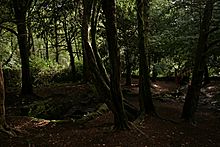|
|
|
|
Gawton's WellSacred Well
|
||||||||||||||||||||||||
|
|
|
Images (click to view fullsize) |
|





|
Fieldnotes |
|
|
Visited 5th October 2013 There’s hardly a surfeit of sacred wells in Staffordshire, so any chance to visit one should be grabbed with both hands, something I had sadly neglected to do for some time, but today’s the day, so we strolled through the woods by Knypersley pool on the hunt for the well. The dappled shade in the trees gave an otherworldly feel as we moved form the relative brightness of the day, passing the dark finger of the Warden’s Tower, poking through the trees on an outcrop to our left. As we moved further into the woods the occasional old moss covered dry stone wall was visible amongst the thickets, as though we were stumbling through a long abandoned hamlet now reclaimed by the forest. Things started promisingly, with clearly marked paths through the woods, and even a sign pointing us the direction of Gawton’s Stone & Well, but although we came upon the imposing edifice of Gawton’s Stone, the well was proving more elusive. Several tracks branched off from the main path, and I try to remember the relative positioning of the sites from the brief glimpse I had of a map of the woodland back at the visitors centre at Greenway Bank. I rue the decision not to bring an O.S. map, and realise now that I should just have photographed the visitors centre map so I could view it again to refer to on the camera. Knowing the well must be close by we pick a path and strike out toward the distant sound of water. It’s not long before we reach a stream, and the source of the sound, a small waterfall over an old stone dyke, and as the path curves further around it becomes clear that it’s not the path to the well. We soon find ourselves back on the main trail again, all sense of direction having been clouded amongst the trees. Walking through the woods makes me think of Robert Holdstock’s novels, this place could almost be Staffordshire’s own mini Mythago Wood, such is character of the place, with hidden landmarks and a sense of nature pervading and reclaiming the once landscaped old country estate. Back at Gawton’s stone I review the brief notes I have about the place, which indicate the well is only about 100 meters to the north of the stone, so trying to gauge the direction by our brief glimpses of the sun through the trees, we spot a track off the main path we had previously passed, and head off again. Only a short way ahead I can see another old lichen covered wall, and an entranceway into a copse of trees, and spotting clouties hanging from the boughs I know we must be in the right place. The well itself is on a gentle slope, surrounded by the protective embrace of a grove of yew trees. A small elliptical stone basin catches the bubbling water, which flows into a larger rectangular one before running off in a thin stream down the slope, before disappearing again into the earth again near the old wall. I’m instantly struck by the atmosphere of the place and can see at once why it is considered one of Staffordshire’s most spiritual sites. The oval stand of yews is reputed to be the remains of a druidic grove, and although these specimens must be considerably younger than that, perhaps they are the descendants of those long forgotten trees. We spend some time here, and it’s nice to find a place that is well cared for, there is no sign of rubbish, the clouties are sympathetic to the site, and even the aborglyphs on the surrounding trees have a spiritual dimension, someone having gone to great effort to carve a fine yin-yang symbol near the base of a tree. The waters of the well have supposed curative properties, being renowned as a ‘cure for the King’s evil’ fortunately I’m not afflicted with any skin complaints on which to try it out, but a splash of the cool water to my face is welcome after all our tramping through the woods. This whole area of Knypersley wood exudes a magical ambiance, in some ways it reminds me a lot of Alderley Edge, having the same sort of feel to it. No matter how old the current well is, it has the same sublime atmosphere I’ve experienced at Cornish holy wells, and was evidently a sacred place to local people long ago, and well, it still is today. |
10th October 2013ce |
Folklore |
|
|
The well has long been associated with curative properties, particularly relating to skin conditions. As well as the supposedly curing the eponymous hermit who lived at Gawton's Stone the well waters were regularly used by local people, who used nearby stone to fashion a small rectangular bathing pool at the site. Writing in 1686, Dr Robert Plot, in 'The Natural History of Stafford-Shire' states: “There are many waters such as the water of the well at Gawton Stone…which has some reputation for the cure of the King’s evil..” The 'King's evil' being the archaic name for the disease scrofula. |
10th October 2013ce |

